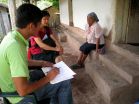(Press-News.org) Imagine taking strands of DNA - the material in our cells that determines how we look and function - and using it to build tiny structures that can deliver drugs to targets within the body or take electronic miniaturization to a whole new level.
While it may still sound like science fiction to most of us, researchers have been piecing together and experimenting with DNA structures for decades. And, in recent years, work by scientists such as McGill University chemistry professor Hanadi Sleiman has moved the use of man-made DNA structures closer to a variety of real-world applications.
But as these applications continue to develop, they require increasingly large and complex strands of DNA. That has posed a problem, because the automated systems used for making synthetic DNA can't produce strands containing more than about 100 bases (the chemicals that link up to form the strands). It can take hundreds of these short strands to assemble nanotubes for applications such as smart drug-delivery systems.
A more economical method
In new research published May 5 in Nature Communications, however, Sleiman''s team at McGill reports that it has devised a technique to create much longer strands of DNA, including custom-designed sequence patterns. What's more, this approach also produces large amounts of these longer strands in just a few hours, making the process potentially more economical and commercially viable than existing techniques.
The new method involves piecing together small strands one after the other, so that they attach into a longer DNA strand with the help of an enzyme known as ligase. A second enzyme, polymerase, is then used to generate many copies of the long DNA strand, yielding larger volumes of the material. The polymerase process has the added advantage of correcting any errors that may have been introduced into the sequence, amplifying only the correctly sequenced, full-length product.
Designer DNA materials
The team used these strands as a scaffold to make DNA nanotubes, demonstrating that the technique allows the length and functions of the tubes to be precisely programmed. "In the end, what we get is a long, synthetic DNA strand with exactly the sequence of bases that we want, and with exactly as many repeat units as we want," explains Sleiman, who co-authored the study with Graham Hamblin, who recently completed his doctorate, and PhD student Janane Rahbani.
"This work opens the door toward a new design strategy in DNA nanotechnology," Sleiman says. "This could provide access to designer DNA materials that are economical and can compete with cheaper, but less versatile technologies. In the future, uses could range from customized gene and protein synthesis, to applications in nanoelectronics, nano-optics, and medicine, including diagnosis and therapy."
INFORMATION:
Partners in research: Funding for the research was provided by the Natural Sciences and Engineering Research Council of Canada, the Fonds de recherché du Québec - Nature et technologies, the Canada Foundation for Innovation, the Canadian Institutes of Health Research, and the Centre for Self-Assembled Chemical Structures.
Video about this research: https://www.youtube.com/watch?v=E7HCvp8na-Y&feature=youtu.be
"Sequential growth of long DNA strands with user-defined patterns for nanostructures and scaffolds," Graham D. Hamblin, Janane F. Rahbani & Hanadi F. Sleiman; Nature Communications, published online May 5, 2015. DOI: 10.1038/ncomms8065
A study of survival rates in trauma patients following health insurance reform in Massachusetts found a passing increase in adjusted mortality rates, an unexpected finding suggesting that simply providing insurance incentives and subsidies may not improve survival for trauma patients, according to a report published online by JAMA Surgery.
Massachusetts introduced health care reform in 2006 to expand health insurance coverage and improve outcomes. Some previous research has suggested improved survival rates following injury in patients with insurance. But the relationship ...
This news release is available in French. Montreal, May 6, 2015 -- Plans for summer holidays are already taking shape. But before jetting off for some fun in the sun, many travellers will have to cope with long delays on the airport runway.
Thanks to new research from Concordia University, however, that time spent twiddling your thumbs on the tarmac could be significantly reduced.
In a new study, forthcoming in the American Institute of Aeronautics and Astronautics' Journal of Aircraft, Concordia mechanical engineering professor Georgios Vatistas describes a new ...
A Stirling scientist who discovered a new Scottish flower has made an unexpected second finding which provides unique insight into our understanding of evolution.
Dr Mario Vallejo-Marin, a Plant Evolutionary Biologist at the University of Stirling, first unearthed a new species of monkeyflower on the bank of a stream in South Lanarkshire, Southern Scotland in 2012.
A subsequent expedition two years later led Dr Vallejo-Marin to locate the impressive yellow flower some 350 miles north, near Stromness on the Orkney Islands off the north coast of Scotland.
"Orkney was ...
There are now over 80,000 apps marketed as "educational" in the Apple app store, the majority of which are targeted towards children and even babies. Parents are led to believe that these apps provide real learning opportunities for their children, but scientific research suggests that many of the apps are nothing more than digital candy.
"Many apps marketed as 'educational' are basically the equivalent of sugary foods," says Kathy Hirsh-Pasek of Temple University, co-author on a new report investigating educational apps. "At best, most of these apps will do no harm; ...
NEW YORK (May 6, 2015) -- To fence or not to fence? That is the question facing conservationists concerned with barriers that keep wildlife in and people out.
According to a new study by the Zoological Society of London (ZSL), Wildlife Conservation Society (WCS) and other groups, appearing in April 20 edition of the Journal of Applied Ecology, new policies must be developed before fences are erected - particularly in dryland ecosystems where mobility is essential for both humans and wildlife.
Some nations are considering fences as a means to protect remnant wildlife ...
This news release is available in German.
An X-ray study carried out at DESY allows to improve the quality of chocolate. The study offers new insights into the formation of fat bloom, an unwelcome white layer that occasionally forms on chocolate. "Although fat blooming is perfectly harmless, it causes millions in damage to the food industry as a result of rejects and customer complaints," explains the main author of the study, Svenja Reinke, from the Hamburg University of Technology (TUHH). "Despite this well known quality issue, comparatively little has been known ...
(BOSTON) - Increasingly, scientists across the world and in the Unites States are reporting new and groundbreaking innovations in biotechnology with transformative implications in human health and environmental sustainability. Examples range from synthetically created, metabolically-engineered bacteria for the sustainable production of fuel to gene editing therapies that could one day help in the prevention and treatment of a large number of human diseases.
While these technologies are developed in laboratories, researchers are not only giving utmost consideration to ...
New Haven, Conn. - Convincing a large group of people to change its behavior is no popularity contest, a new study shows.
In a novel experiment, researchers found that certain public health interventions work best when key "influencers" in a face-to-face social network are exposed to the program. What's surprising, they say, is that those key influencers are not the most socially connected people in the network.
Furthermore, those individuals can be identified through a survey method informed by network structure rather than costly and time-consuming social network mapping. ...
Maybe it's not such a dog-eat-dog world after all. A clever combination of two different types of computer simulations enabled a group of Illinois researchers to uncover an unexpectedly cooperative group dynamic: the spontaneous emergence of resource sharing among individuals in a community. Who were the members of this friendly, digitally represented collective? Escherichia coli, rod-shaped bacteria found in the digestive systems of humans and many other animals.
The finding, initially predicted by mathematical models and then confirmed through empirical testing, was ...
Chocolate is one of the world's most popular foods, but when a whitish coating called a bloom appears on the confection's surface, it can make consumers think twice about eating it. The coating is made up of fats and is edible, but it changes the chocolate's appearance and texture -- and not for the better. Now scientists report in the journal ACS Applied Materials & Interfaces new information that could help chocolatiers prevent blooms from forming.
Svenja K. Reinke and colleagues explain that baked goods and confectionery products, including chocolate, contain a mix ...



